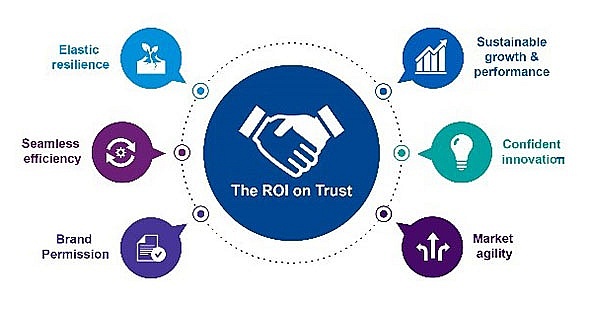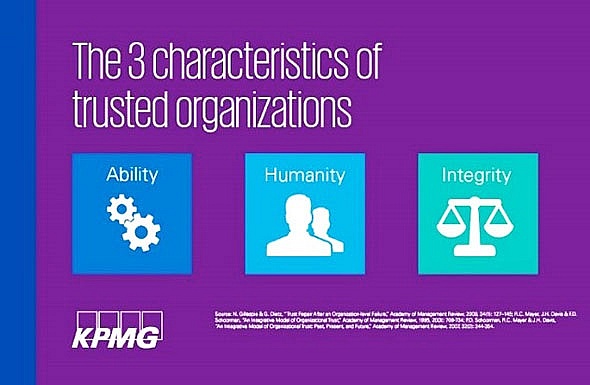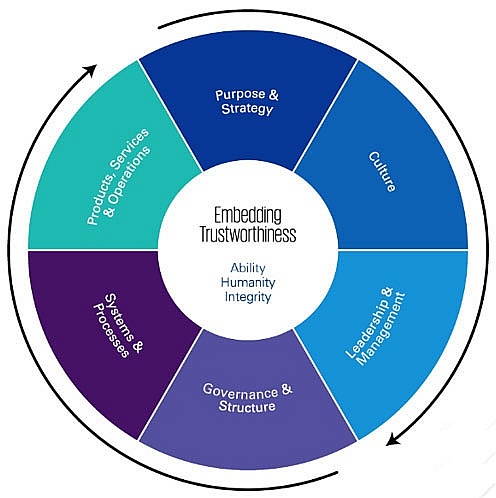The trust imperative – how to build and sustain the trust of your stakeholders
Compared with areas like front-office digital transformation, risk and regulation are sometimes viewed as staid necessities that slow down the business.
The truth is, however, when you address risk and regulation in a disciplined way, through the eyes of all stakeholders, it doesn’t hold you back – it can give you the freedom to go fast.
When you earn the trust of your stakeholders – customers, employees, suppliers, and investors – it gives you the permission to confidently create new technologies, markets, and customer experiences, because you have built trust into your systems and processes, and people want to do business with and work for organisations they trust.
 |
And while the return on investment isn’t always obvious, it can be found gained by avoiding fines because you complied with a regulatory requirement, keeping customers because you protected their data, or attracting and retaining top talent because you’re a trusted organisation.
The fundamentals of trustworthy organisations
According to KPMG 2021 CEO Outlook, 475 CEOs surveyed in Asia-Pacific agreed that three themes uniting them are confidence, trust, and preparedness to create a successful future that’s also sustainable.
Research suggests that people trust organisations that demonstrate three key characteristics:
 |
Ability means trusted organisations have the collective knowledge, skills, and abilities to reliably provide their products and services.
Humanity means trusted organisations go beyond a profit motive and show they care for stakeholders. It’s no wonder that environmental, social, and governance activities are becoming top concerns in the boardroom, as stakeholders want to work with companies that share their values.
Integrity means trusted organisations are also respected for doing the right thing, drawing on principles such as honesty, fairness, ethics, communication, and fulfilment. Integrity also comes into play when organisations must publicly react to a difficult issue.
The moments that matter
Trust is built on consistent, predictable action in the moments that matter. Indeed, even if you say and do the right things, a failure at a critical moment can undermine the trusted reputation you have worked hard to earn. That’s why it’s important to weave security, compliance, and trust into all systems and transformation activities.
We highlighted the six elements of trust to help earn and sustain the trust of your stakeholders, and embed trustworthiness throughout your business.
 |
Purpose & Strategy means having a clear purpose and strategy with trust-inducing core values that create value for society and accommodate stakeholders’ interests.
Culture includes shared values, beliefs, and norms that foster constructive trust-inducing behaviour aligned with the organisation's purpose.
Leadership & Management represents leaders who embody the company values and purpose and hold themselves and others accountable.
Governance & Structure means being a formal organisation with governance that set clear roles and provides discretion within prudent oversight.
Systems & Processes refers to leverage and aligned planning, management, HR, reporting, and compliance systems to reinforce trustworthy behaviour in line with the legal and regulatory context.
Products, Services & Operations help ensure stakeholder needs and expectations are met, legislation adhered to, and values upheld.
In conclusion, the way we see it, trust is the ultimate business enabler, and your risk and regulatory functions help create it.
As the enterprise evolves, the six elements of trust should receive an appropriate level of attention. Risk and regulatory functions following a dynamic approach are at the heart of organisations that have the three key trusted characteristics: ability, humanity, and integrity.
Organisations should go beyond reactive defence and passive compliance to actively anticipate risks and opportunities and detect system failures before it’s too late. That’s how you inspire stakeholder trust and help create a successful future that’s also sustainable.
 |
| By Truong Hanh Linh, Partner, head of Risk Consulting at KPMG Vietnam (left) and Truong Quynh Hoa, director of Risk Consulting at KPMG Vietnam |
What the stars mean:
★ Poor ★ ★ Promising ★★★ Good ★★★★ Very good ★★★★★ Exceptional
Related Contents
Latest News
More News
- KPMG launches tariff modeller in Vietnam to navigate US tariff risks (July 29, 2025 | 12:11)
- Removing hidden barriers to unlock ASEAN trade (June 29, 2025 | 11:31)
- New report charts path for Vietnam’s clinical trial growth (May 21, 2025 | 08:58)
- TTC Agris strengthens market position with investment in Bien Hoa Consumer JSC (May 19, 2025 | 10:14)
- World Bank to help SBV build shared database for banking industry (April 09, 2025 | 08:55)
- New trade alliances and investment hubs are redefining global power dynamics (April 03, 2025 | 17:00)
- ACCA and KPMG forge path for business leaders to pioneer ESG excellence (March 07, 2025 | 10:09)
- VietBank signs MoU with KPMG (February 26, 2025 | 18:47)
- Warrick Cleine MBE: an honour for services to British trade and investment in Vietnam (December 31, 2024 | 20:16)
- KPMG report offers fresh insight into leveraging AI (December 24, 2024 | 09:23)

 Tag:
Tag:


















 Mobile Version
Mobile Version